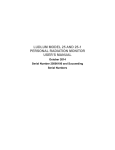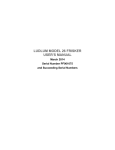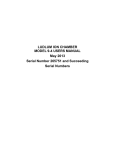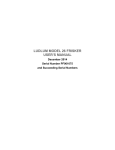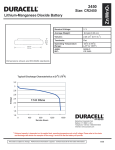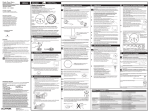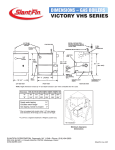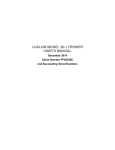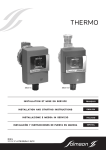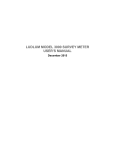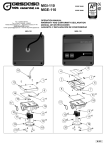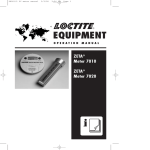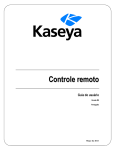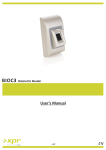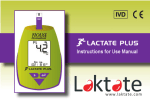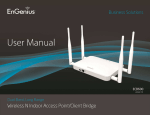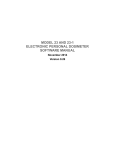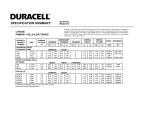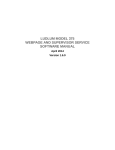Download LUDLUM MODEL 25 - Ludlum Measurements, Inc.
Transcript
LUDLUM MODEL 25-IS & MODEL 25-IS-1 INTRINSICALLY SAFE PERSONAL RADIATION MONITOR USER’S MANUAL October 2010 Serial Number 25000100 and Succeeding Serial Numbers LUDLUM MODEL 25-IS & 25-IS-1 INTRINSICALLY SAFE PERSONAL RADIATION MONITOR USER’S MANUAL October 2010 Serial Number 25000100 and Succeeding Serial Numbers NOTE: Changes to this manual require the written approval of MET Laboratories, Baltimore, Maryland. LUDLUM MEASUREMENTS, INC. 501 OAK STREET, P.O. BOX 810 SWEETWATER, TEXAS 79556 325-235-5494, FAX: 325-235-4672 Read Before Operating This manual must be carefully read by all individuals who have or will have the responsibility of using, maintaining, or servicing this product. The product will perform as designed only if it is used, maintained, and serviced in accordance with the manufacturer’s instructions. CAUTION! To reduce the risk of electric shock, turn off power and remove batteries before removing the monitor cover. Never operate this monitor while the cover is removed. Remove monitor cover only in an area known to be non-hazardous. WARNING! Use only Duracell DL2450 Batteries. WARNING! Substitution of components may impair intrinsic safety. Model 25-IS & 25-IS-1 Personal Radiation Monitor User’s Manual Table of Contents Introduction 1 Getting Started 2 Warnings 2-1 Unpacking and Repacking 2-2 Battery Installation 2-2 Instrument Operational Test 2-2 Instrument Use and Controls 2-3 Distinguishing ALERTs and ALARMs 2-6 Specifications 3 Calibration and Changing Parameters 4 Calibration Overview 4-1 Entering SETUP Mode and Changing Parameters 4-2 Calibration Procedure 4-3 Safety Considerations 5 Environmental Conditions for Normal Use 5-1 Warning Markings and Symbols 5-1 Cleaning and Maintenance Precautions 5-2 Revision History 6 Recycling 7 Model 25-IS & 25-IS-1 Personal Radiation Monitor 1 User’s Manual Section 1 Section Introduction T he Model 25-IS and the Model 25-IS-1 are intrinsically safe personal radiation detection and warning instruments that are designed to be intrinsically safe in Class 1 Division 1, Group A, B, C, and D hazardous conditions. The instruments feature a large backlit LCD (liquid crystal display), a bright (daylight-visible) warning light, and a piercing audio warning. The unit body is made of lightweight but durable plastic and can survive brief immersion in water. The Model 25–IS may be clipped to a belt or worn around the neck with a lanyard. The Model 25-IS-1 readout is in mSv/h or Sv/h; whereas the Model 25-IS readout is in mR/hr or R/hr. This being the only difference between the two, this manual will refer to the two instruments as “Model 25-IS.” The detector inside the Model 25-IS measures gamma radiation from background levels up to 200 R/hr (2 Sv/h). The display, which normally shows exposure rate, will also display total accumulated dose, and time remaining. In an alarm situation, the display (automatically backlit if light levels are dim) rotates every two seconds among the three displays: exposure rate, accumulated dose, and time remaining. Thus, in an emergency situation, a responder can be warned of the radiation level and informed of the time remaining before their maximum allowed dose is reached. Setup of the instrument is accomplished also through the front panel buttons. The advanced user or administrator can set ALERT and ALARM levels (both exposure rate and accumulated dose), change calibration parameters, and zero the total accumulated dose within the setup routine. The unit is operated with two coin cell batteries for operation from -40 to 65 °C (-40 to 150 °F). Battery life should be approximately 6000 hours under non-alarming conditions. A low-battery indicator on the LCD warns when less than eight hours of battery life remain. Ludlum Measurements, Inc. Page 1-1 October 2010 Model 25-IS & 25-IS-1 Personal Radiation Monitor 2 User’s Manual Section 2 Section Getting Started Important: This instrument is designed to be INTRINSICALLY SAFE in Class I Division I Group A, B, C, and D Hazardous locations. Warning: Use only DL2450 (NEDA/ANSI/IEC/ #5029LC) coin cell batteries. To reduce the risk of ignition of a flammable or explosive atmosphere, batteries must be changed only in a location known to be a non-hazardous area. Warning: When repairing this unit, substitution of components may impair INTRINSIC SAFETY. Avertissement: La substitution de composants peut compromettre la SECURITE INTRINSEQUE. Afin de prevenir I’Inflammation D’Atmospheres dangereuses, ne changer les batteries que dans des emplacements designes non dangereux. Ludlum Measurements, Inc. Page 2-1 October 2010 Model 25-IS & 25-IS-1 Personal Radiation Monitor User’s Manual Section 2 Warning: If worn on a lanyard, ensure that a breakaway device is used to prevent entanglement accidents. Unpacking and Repacking Remove the calibration certificate and place it in a secure location. Remove the instrument and accessories (lanyard, case, etc.) and ensure that all of the items listed on the packing list are in the carton. Check individual item serial numbers and ensure calibration certificates match. The Model 25-IS serial number is located on the back panel below the battery compartments. To return an instrument for repair or calibration, provide sufficient packing material to prevent damage during shipment. Include brief information as to the reason for return, as well as return shipping instructions: • • • • Return shipping address Customer name or contact Telephone number Description of service requested and all other necessary information Battery Installation Open each battery lid by using a large coin or screwdriver to unscrew (counter-clockwise) the two round battery holders on the back of the instrument. Remove the two old batteries, and replace with new batteries. Ensure that both batteries have the plus (+) sign facing outwards. Screw each battery holder clockwise until the holder is flush with the case. Battery replacement may be done by the user, and is not considered a reason for recalibration. Instrument Operational Test Turn the instrument ON by pressing the ON/ACK button for about a second, and then releasing. The instrument should activate all the LCD segments, the audio, and the warning light. It then displays a version number before displaying the current exposure rate, normally 0.0 mR/hr (or 0.000 mSv/h). Ensure that the low-battery indicator is not present. If the low-battery indicator is present, replace the batteries as soon as possible. Under Ludlum Measurements, Inc. Page 2-2 October 2010 Model 25-IS & 25-IS-1 Personal Radiation Monitor User’s Manual Section 2 extremely low battery conditions, be aware that the unit may not even turn on, or may turn itself off abruptly. If possible, expose the detector to a source of radiation. Small check sources of radiation are available from Ludlum Measurements that, while exempt from many regulations because of their small size, are large enough to produce a response on this instrument. The detector's position is marked by the small plus (+) sign on the front panel of the Model 25-IS. A typical 1 µCi (37 kBq) 137Cs check source will produce an exposure rate of approximately 3 mR/hr. If this procedure is done routinely with the same radiation source, instrument malfunction may be detected when anomalous readings are observed. A reference reading with a check source should be obtained at the time of calibration or at the time the instrument is received in the field. If at any time the instrument fails to read within 20% of the reference reading when using the same check source, it should be sent to a calibration facility for recalibration and/or repair. Note that the Model 25-IS has its own diagnostic tests to ensure that the detector is functioning correctly. The Model 25-IS can detect when the radiation detector is malfunctioning and will flash “0.0 mR/hr” (“0.000 mSv/h”) with “F,” the warning audio, and the light to indicate a detector malfunction. If this indication is observed, remove the unit from service and have it evaluated by a qualified repair and calibration technician. Once this procedure has been completed, the instrument is ready for use. Instrument Use and Controls With only two front-panel buttons, the Ludlum Model 25-IS is simple and easy to use with minimal training required. Under typical use, the display shows just the current exposure rate. Whenever the MODE button is pressed, or during an ALERT or ALARM condition, the display rotates among the exposure rate, the total accumulated dose, and the time remaining (in hh:mm format). The additional display modes may help the user to decide how long to stay in a high radiation area. See the Model 25-IS front-panel drawing at the beginning of this manual to reference the following controls: ON/ACK button: Used to power the Model 25-IS ON and OFF, and acknowledge audio on alerts and alarms. ON: Press for approximately one second and release (all LCD segments will activate, and firmware version will be shown). Ludlum Measurements, Inc. Page 2-3 October 2010 Model 25-IS & 25-IS-1 Personal Radiation Monitor User’s Manual Section 2 OFF: Press for approximately five seconds (audio will beep and LCD will clear). ACK (acknowledge): will silence audio during an ALERT or ALARM condition, but in an ALARM condition the audio will continue to be activated once every 60 seconds to remind the user. MODE button: When pressed under non-alarm conditions, the display rotates between the total accumulated dose, the time remaining, and back to the normal exposure rate display. If the light is very dim, pressing the MODE button will also turn on the backlight while the display cycles among the three display modes. The Exposure Rate (main active screen) at typical background radiation levels shows a number similar to 0.04 mR/hr. Figure 1 also shows the low battery icon. Figure 1: Exposure Rate Screen showing typical background radiation rate and also showing low-battery icon Ludlum Measurements, Inc. Page 2-4 October 2010 Model 25-IS & 25-IS-1 Personal Radiation Monitor User’s Manual Section 2 The Accumulated Dose screen is shown in Figure 2. 80.5 R is a significant dose, and thus Figure 2 also shows the ALARM indication. Figure 2: Accumulated Dose Screen with ALARM indicator The Time Remaining screen shown in Figure 3 displays 10 hours and 30 minutes (10:30) remaining before the user receives the maximum allowed accumulated dose. An "ALERT" indication is also shown in Figure 3. Figure 3: Time Remaining Screen with ALERT indication Ludlum Measurements, Inc. Page 2-5 October 2010 Model 25-IS & 25-IS-1 Personal Radiation Monitor User’s Manual Section 2 Distinguishing ALERTs and ALARMs There are four independent radiation alarms: Exposure Rate ALERT: distinguished by the word ALERT in the exposure rate display and a slow, single beep of the audio. Exposure Rate ALARM: distinguished by the word ALARM in the exposure rate display and a fast, single beep of the audio. Accumulated Dose ALERT: distinguished by the word ALERT in the accumulated dose display and a slow, double beep of the audio. Accumulated Dose ALARM: distinguished by the word ALARM in the accumulated dose display and a fast, double beep of the audio. Note that an ALARM condition will override a lower priority ALERT condition. The audible alarms consist of a single frequency tone and are easily distinguishable from the Personal Alert Safety System (PASS) alarms typically worn by firefighters. Ludlum Measurements, Inc. Page 2-6 October 2010 Model 25-IS & 25-IS-1 Personal Radiation Monitor 3 User’s Manual Section 3 Section 0 Specifications Linearity: reading within 10% of true value within calibration range Angular Response: <25% deviation from 137Cs response, detector axis parallel to field Gamma Response: typically 18 cpm per mR/hr Beta Response: typically <0.10 mR/hr (< 0.001 mSv/h) with a 101 kdpm 90 SrY beta source on contact Neutron Response: typically 0.3 mR/hr (0.003 mSv/h) in a 10 mrem/hr (0.1 mSv/h) neutron field from a brass shielded Am-Be source Self-Diagnostics: If no pulses are received from the detector in 60 minutes, instrument failure is indicated by an audible and visual alarm, and the display alternating between “0.0” and “F.” Response Time: varies by exposure rate, faster response times with high exposure rates; normally under 10 seconds from <1 to 10 mR/hr (0.1 mSv/h), 2 seconds or less from <1 to 50 mR/hr (0.5 mSv/h) Detector High Voltage: internally fixed at 550 Vdc Battery Dependence: less than 3% change in readings to battery failure indication End-of-Battery Life Warning: At approximately 2.3 Vdc, the low-battery symbol is displayed on the front panel LCD, indicating eight hours of use remain. Below 2.0 Vdc, the unit may abruptly turn off (blank the display). Display: backlit 1.3 cm (0.5 in.) digits with readings from 0.00 to 19.99, or from 0:00 to 19:59 in hours/min format, indications of (m)R(/h), ALERT, ALARM, and a low-battery symbol Display range: for 25-IS: 0.01 mR/hr to 1000 R/hr for 25-IS-1: .001 mSv/h to 10 Sv/h Calibrated range (exposure rate): normally calibrated from 2 mR/hr to 200 R/hr (0.02 mSv/h to 2 Sv/hr). Ludlum Measurements, Inc. Page 3-1 October 2010 Model 25-IS & 25-IS-1 Personal Radiation Monitor User’s Manual Section 3 Calibration Controls: Front-panel buttons provide setup routine to view or change ALERT and ALARM setpoints, calibration constants, and to zero the accumulated dose. Audio: built-in speaker with a typical intensity of 95 dB at 30.4 cm (1 ft) at a frequency of 3.5 kHz Power: two DL2450 (NEDA/ANSI/IEC #5029LC) coin cell batteries housed in two externally accessible compartments Battery Life: typically 6000 hours under non-alarm conditions Size: 7.6 x 5.4 x 1.7 cm (3 x 2.1 x 0.69 in.) (H x W x thickness) Weight: 158.6 g (5.1 oz) including batteries Temperature Range: -40 to 65 °C (-40 to 150 °F) Construction: injection-molded plastic body Environmental Rating: IP 67 or NEMA 5; constructed for either indoor or outdoor use to provide a degree of protection against falling dirt, rain, sleet, and snow, including temporary immersion. Ludlum Measurements, Inc. Page 3-2 October 2010 Model 25-IS & 25-IS-1 Personal Radiation Monitor 4 User’s Manual Section 4 Section Calibration and Changing Parameters Warning! Only advanced users or administrators should consider changing any of the parameters in the following section. Incorrect settings could jeopardize the safety of users depending on this instrument. Calibration Overview Your instrument has been shipped from Ludlum Measurements only after passing electronic checkout, a 30-hour burn-in process, and a careful calibration process. Calibration papers are supplied with each instrument shipped from Ludlum Measurements. Recalibration should be accomplished after maintenance or adjustments have been performed on the instrument. Recalibration is not normally required following instrument cleaning or battery replacement. Recalibration does not require any special tools or software to perform. Ludlum Measurements offers a full-service repair and calibration department. Not only do we repair and calibrate our own instruments, we also service most other manufacturers’ instruments. Calibration procedures are available upon request for customers who choose to calibrate their own instruments. Note: Ludlum Measurements, Inc. recommends recalibration at intervals no greater than two years, assuming that regular operational checks are performed. Check the appropriate local, state, and federal regulations to determine required recalibration intervals. Ludlum Measurements, Inc. Page 4-1 October 2010 Model 25-IS & 25-IS-1 Personal Radiation Monitor User’s Manual Section 4 Note: Calibration of the Model 25-IS requires a gamma radiation source (typically 137Cs) that is traceable to a national standard or other suitable reference, and that can produce radiation fields from 2 mR/hr to 800 R (0.02 mSv/h to 8 Sv/h). Before calibrating the instrument, the user may wish to adjust the ALERT and ALARM setpoints to 999. Entering SETUP Mode and Changing Parameters Calibration involves the changing of parameters accessed via the SETUP mode. The following parameters are adjustable to suit the user’s needs (default values are in parentheses). Radiological alert and alarm parameters are values recommended by the National Council on Radiation Protection and Measurements (NCRP). Rate Alert (10 mR/hr) (0.1 mSv/h) Rate Alarm (10 R/hr) (0.1 Sv/h) Dose Alert (10 R) (0.1 Sv) Dose Alarm (50 R) (0.5 Sv) Calibration Constant (300 cps/R/hr) ( 300 cps per 0.01 Sv/h) Dead Time Constant (30 µsec) Series Constant (285) NOTE: Successful completion of the SETUP mode also zeros the accumulated dose. Powering down (by pressing the ON/ACK button) will result in change to parameters or the accumulated dose. Entering Setup Mode To enter setup mode, power down the Model 25, then turn the unit back ON. When 0.00 mR/hr (0.000 mSv/h) appears on the LCD, press the MODE button three times within four seconds to enter Setup Mode. You will know that the unit is in SETUP mode when the display suddenly changes to 10 mR/hr ALERT (or whatever the current rate alert is set to). If you simply wish to view the parameters, you may do so by not pressing any other buttons. The parameters will change every four seconds when no buttons are pressed. The unit will return automatically to normal mode after the last parameter is presented. Using Setup Mode to Change Parameters Once the Model 25-IS is in SETUP mode, the Rate Alert Setpoint should be displayed on the LED and the units for the Rate Alert Setpoint Ludlum Measurements, Inc. Page 4-2 October 2010 Model 25-IS & 25-IS-1 Personal Radiation Monitor User’s Manual Section 4 (mR/hr, R/hr, mSv/h, or Sv/h) should be blinking. For the first four parameters (Rate Alert, Rate Alarm, Dose Alert, and Dose Alarm), there are five items to adjust, namely : Units (mR/hr, R/hr, mSv/h, or Sv/h) Number of Decimal Places (0, 1, or 2) Ones Place (0-9) Tens Place (0-9) Hundreds Place (0-9) NOTE: The remaining parameters do not have the option to change the units or the number of decimal places. Use the MODE button to toggle the options for the selected item. When the appropriate value is selected for that item, press the ON/ACK button to adjust the next item. When the desired Rate Alert Setpoint is displayed, simply wait for four seconds. The Model 25-IS will then switch to the next parameter (Rate Alarm Setpoint in this case). NOTE: If no buttons are pressed for four seconds, the Model 25-IS will switch to the next parameter, and if on the last parameter, will save the parameters and exit SETUP mode. Repeat this process until all of the setup parameters are set to the desired values. After the last setup mode (Series Constant), the Model 25-IS will resume normal activity after four seconds of inactivity. Calibration Procedure Expose the instrument to a radiation field of 80 mR/hr (0.8 mSv/h) and adjust the Calibration Constant until the Model 25-IS display reads within 10% of 80.0 mR/hr (0.8 mSv/h). Expose the instrument to a radiation field of 80 R/hr (0.8 Sv/h) and adjust the Dead Time Constant until the Model 25 display reads within 10% of 80.0 R/hr (0.8 Sv/h). Expose the instrument to a radiation field of 800 R/hr (8 Sv/h), and adjust the Series Constant until the Model 25 display reads within 10% of 800 R/hr (8 Sv/h). Record and document the following readings, and verify that all of the readings are within 10% of the appropriate radiation field: Ludlum Measurements, Inc. • 2 mR/hr (0.02mSv/h) and 8 mR/hr 0.08 mSv/h) • 20 mR/hr (0.2 mSv/h) and 80 mR/hr (0.8 mSv/h) Page 4-3 October 2010 Model 25-IS & 25-IS-1 Personal Radiation Monitor User’s Manual Ludlum Measurements, Inc. Section 4 • 200 mR/hr (2 mSv/h) and 800 mR/hr (8 mSv/h) • 2 R/hr (0.02 Sv/h) and 8 R/hr (0.08 Sv/h) • 20 R/hr (0.2 Sv/h) and 80 R/hr (0.8 Sv/h) • 200 R/hr ( 2 Sv/h) • Reset the ALERT and ALARM setpoints to the desired levels. Record all parameters. Page 4-4 October 2010 Model 25-IS & 25-IS-1 Personal Radiation Monitor 5 User’s Manual Section 5 Section Safety Considerations Environmental Conditions for Normal Use Indoor or outdoor use No maximum altitude Temperature range of -40 to 65 °C (-40 to 150 °F) Maximum relative humidity of less than 95% (non-condensing) Pollution Degree 3 (as defined by IEC 664): (Occurs when conductive pollution or dry nonconductive pollution becomes conductive due to condensation. This is typical of industrial or construction sites.) Certified for use in an explosive atmosphere (See Introduction) Warning Markings and Symbols Caution! The operator or responsible body is cautioned that the protection provided by the equipment may be impaired if the equipment is used in a manner not specified by Ludlum Measurements, Inc. The Model 25-IS Survey Meter is marked with the following symbols: CAUTION (per ISO 3864, No. B.3.1): designates hazardous live voltage and risk of electric shock. During normal use, internal components are hazardous live. This instrument must be isolated or disconnected from the hazardous live voltage before accessing the internal components. This symbol appears on the back panel. Ludlum Measurements, Inc. Page 5-1 October 2010 Model 25-IS & 25-IS-1 Personal Radiation Monitor User’s Manual Section 5 The “crossed-out wheelie bin” symbol notifies the consumer that the product is not to be mixed with unsorted municipal waste when discarding. Each material must be separated. The symbol is placed on the serial number label located on the back panel. See section 7, “Recycling,” for further information. The “CE” mark is used to identify this instrument as being acceptable for use within the European Union. Cleaning and Maintenance Precautions The Model 25-IS may be cleaned externally with a damp cloth, using only water as the wetting agent. Observe the following precautions when cleaning or performing maintenance on the instrument: 1. Turn the instrument OFF and remove the batteries. 2. Allow the instrument to sit for one minute before cleaning the exterior or accessing any internal components for maintenance. Ludlum Measurements, Inc. Page 5-2 October 2010 Model 25-IS & 25-IS-1 Personal Radiation Monitor 6 User’s Manual Section 6 Section Revision History NOTE: This section of the manual will be updated with each revision of the Model 25-IS in order to document changes over time. Ludlum Measurement’s policy is to provide free software upgrades to instruments for the life of the instrument. Revision-October 2010: Added cover regarding compliance and requirement to get approval from MET Labs for changes to this manual; Updated revision history Revision-February 2010: Updated drawing in front of manual; Added warnings to Section 2; Updated order of specs; Corrected for style and grammar Revision-May 2008: “401” shown on power-up (25-1) –“402” Original January 2008: “309” shown on power-up (25-1) – “310” Ludlum Measurements, Inc. Page 6-1 October 2010 Model 25-IS & 25-IS-1 Personal Radiation Monitor User’s Manual 7 Section 7 Section Recycling udlum Measurements, Inc. supports the recycling of the electronics products it produces for the purpose of protecting the environment and to comply with all regional, national, and international agencies that promote economically and environmentally sustainable recycling systems. To this end, Ludlum Measurements, Inc. strives to supply the consumer of its goods with information regarding reuse and recycling of the many different types of materials used in its products. With many different agencies – public and private – involved in this pursuit, it becomes evident that a myriad of methods can be used in the process of recycling. Therefore, Ludlum Measurements, Inc. does not suggest one particular method over another, but simply desires to inform its consumers of the range of recyclable materials present in its products, so that the user will have flexibility in following all local and federal laws. The following types of recyclable materials are present in Ludlum Measurements, Inc. electronics products, and should be recycled separately. The list is not all-inclusive, nor does it suggest that all materials are present in each piece of equipment: Batteries Glass Aluminum and Stainless Steel Circuit Boards Plastics Liquid Crystal Display (LCD) Ludlum Measurements, Inc. products that have been placed on the market after August 13, 2005, have been labeled with a symbol recognized internationally as the “crossed-out wheelie bin,” which notifies the consumer that the product is not to be mixed with unsorted municipal waste when discarding. Each material must be separated. On the Model 25-IS, the symbol will be placed on the serial number label located on the back panel of the instrument. The symbol appears as such: Ludlum Measurements, Inc. Page 7-1 October 2010























